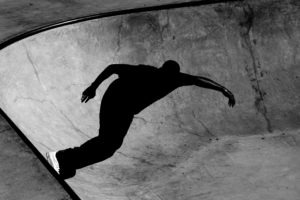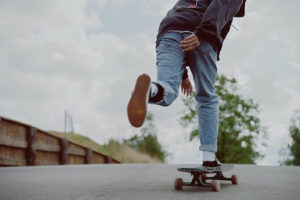Whether you are brand new to skateboarding and picking up your first complete skateboard, or you have been skating for years, you already know it comes with risk of injury! Skateboarding, like most other sports, comes with risk, but do not let that stop you from enjoying it. For those of you who are starting out, do not be discouraged, as falls and other mishaps are an inevitable part of everyone’s skateboarding journey.
There are an estimated 70,000 skateboarding-related injuries annually. Statistics say that one-third of the related injuries are coming from first-timers or those who are newer to skateboarding. This might feel like an alarming number but practicing safety can prevent you from becoming a part of this statistic!
Safety must always be the number one priority. In this article, we will be discussing some tips for avoiding the most common skateboarding injuries. This is not only for those who are just starting out, but these reminders will also serve those who have been skating almost all their lives!
The Most Common Skateboarding Injuries
Arguably the most common injuries are those relating to the head. This type of injury is often the most serious as well. They can be mild bruises, concussions, or even result in extreme cases like permanent brain injury or death. Since skateboarding is all about balance and coordination, head injuries can happen any time you lose control of your board and fall. Sometimes external factors can come into play, such as a car, road hazard, other skateboarders, pedestrians, or even the obstacles you are deliberately hitting.
In a nutshell, injuries can happen no matter what kind of surface you are on. Because of this, the best way to avoid head injuries is by learning the basics of how to fall properly. One way to do this is to learn how to break your fall smoothly, instead of the more painful (and riskier) way of slamming your out-of-control body into the ground. Sliding or rolling can be two key tricks that can help you in the long run if done properly.
It’s easier said than done, but by learning how to fall properly, you instantly reduce the chances of your head being the first to hit the ground instead of other parts of your body. Another piece of advice is to use the fleshier parts of your body, such as your arms, instead of resorting to using your hands. This is also one way to avoid one of the most common injuries related to skateboarding, which is hand, arm, and wrist injuries.
Other Helpful Tips
Maybe you have already learned to fall from skiing or snowboarding, then you know the best way to make the most out of your falls is to learn from them, learn from your mistakes. When you are trying something new, it likely will not click right away, which is okay. It is important though to know when to call it quits and save a trick for later. It helps to pause, assess, and figure out what can be done better rather than continuing to wear yourself out, increasing the risk of injury.
Another important aspect to focus on is learning one technique at a time and perfecting it before you move on or build onto it. It is best to take things one step at a time and enjoy the learning process, this is the safest way to go about it. So, start with easier, confidence boosting tricks, and save the harder ones for after you have mastered the “easy” ones on your skateboard, to avoid injuries.
Lastly, be sure to practice new tricks and skills in a safe and designated skating environment. That way, you have fellow skaters to assist you and provide pointers, and you can skate with confidence that there won’t be cars or other hazards.
Protective Skateboarding Gear
Lastly, wearing protective gear and equipment is important. A helmet along with some elbow and knee pads can go a long way prevent injuries on your skateboard. Once you are sure you have everything you need, you will feel a lot more confident trying something new.
We hope that these tips help you stay safe and avoid injury, whether you are just starting out or have been skateboarding for years!








